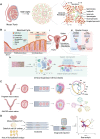Dissecting mammalian reproduction with spatial transcriptomics
- PMID: 37353907
- PMCID: PMC10628492
- DOI: 10.1093/humupd/dmad017
Dissecting mammalian reproduction with spatial transcriptomics
Abstract
Background: Mammalian reproduction requires the fusion of two specialized cells: an oocyte and a sperm. In addition to producing gametes, the reproductive system also provides the environment for the appropriate development of the embryo. Deciphering the reproductive system requires understanding the functions of each cell type and cell-cell interactions. Recent single-cell omics technologies have provided insights into the gene regulatory network in discrete cellular populations of both the male and female reproductive systems. However, these approaches cannot examine how the cellular states of the gametes or embryos are regulated through their interactions with neighboring somatic cells in the native tissue environment owing to tissue disassociations. Emerging spatial omics technologies address this challenge by preserving the spatial context of the cells to be profiled. These technologies hold the potential to revolutionize our understanding of mammalian reproduction.
Objective and rationale: We aim to review the state-of-the-art spatial transcriptomics (ST) technologies with a focus on highlighting the novel biological insights that they have helped to reveal about the mammalian reproductive systems in the context of gametogenesis, embryogenesis, and reproductive pathologies. We also aim to discuss the current challenges of applying ST technologies in reproductive research and provide a sneak peek at what the field of spatial omics can offer for the reproduction community in the years to come.
Search methods: The PubMed database was used in the search for peer-reviewed research articles and reviews using combinations of the following terms: 'spatial omics', 'fertility', 'reproduction', 'gametogenesis', 'embryogenesis', 'reproductive cancer', 'spatial transcriptomics', 'spermatogenesis', 'ovary', 'uterus', 'cervix', 'testis', and other keywords related to the subject area. All relevant publications until April 2023 were critically evaluated and discussed.
Outcomes: First, an overview of the ST technologies that have been applied to studying the reproductive systems was provided. The basic design principles and the advantages and limitations of these technologies were discussed and tabulated to serve as a guide for researchers to choose the best-suited technologies for their own research. Second, novel biological insights into mammalian reproduction, especially human reproduction revealed by ST analyses, were comprehensively reviewed. Three major themes were discussed. The first theme focuses on genes with non-random spatial expression patterns with specialized functions in multiple reproductive systems; The second theme centers around functionally interacting cell types which are often found to be spatially clustered in the reproductive tissues; and the thrid theme discusses pathological states in reproductive systems which are often associated with unique cellular microenvironments. Finally, current experimental and computational challenges of applying ST technologies to studying mammalian reproduction were highlighted, and potential solutions to tackle these challenges were provided. Future directions in the development of spatial omics technologies and how they will benefit the field of human reproduction were discussed, including the capture of cellular and tissue dynamics, multi-modal molecular profiling, and spatial characterization of gene perturbations.
Wider implications: Like single-cell technologies, spatial omics technologies hold tremendous potential for providing significant and novel insights into mammalian reproduction. Our review summarizes these novel biological insights that ST technologies have provided while shedding light on what is yet to come. Our review provides reproductive biologists and clinicians with a much-needed update on the state of art of ST technologies. It may also facilitate the adoption of cutting-edge spatial technologies in both basic and clinical reproductive research.
Keywords: cancer; embryogenesis; gametogenesis; pregnancy; reproduction; spatial transcriptomics.
© The Author(s) 2023. Published by Oxford University Press on behalf of European Society of Human Reproduction and Embryology.
Conflict of interest statement
The authors declare no conflict of interest concerning this review.
Figures



Similar articles
-
Bioengineering trends in female reproduction: a systematic review.Hum Reprod Update. 2022 Nov 2;28(6):798-837. doi: 10.1093/humupd/dmac025. Hum Reprod Update. 2022. PMID: 35652272 Free PMC article.
-
Computational solutions for spatial transcriptomics.Comput Struct Biotechnol J. 2022 Sep 1;20:4870-4884. doi: 10.1016/j.csbj.2022.08.043. eCollection 2022. Comput Struct Biotechnol J. 2022. PMID: 36147664 Free PMC article. Review.
-
Sirtuins in gamete biology and reproductive physiology: emerging roles and therapeutic potential in female and male infertility.Hum Reprod Update. 2018 May 1;24(3):267-289. doi: 10.1093/humupd/dmy003. Hum Reprod Update. 2018. PMID: 29447380 Review.
-
Age-associated epigenetic changes in mammalian sperm: implications for offspring health and development.Hum Reprod Update. 2023 Jan 5;29(1):24-44. doi: 10.1093/humupd/dmac033. Hum Reprod Update. 2023. PMID: 36066418 Free PMC article. Review.
-
SARS-CoV-2, fertility and assisted reproduction.Hum Reprod Update. 2023 Mar 1;29(2):177-196. doi: 10.1093/humupd/dmac037. Hum Reprod Update. 2023. PMID: 36374645 Free PMC article. Review.
Cited by
-
Spatial multi-omics: deciphering technological landscape of integration of multi-omics and its applications.J Hematol Oncol. 2024 Aug 24;17(1):72. doi: 10.1186/s13045-024-01596-9. J Hematol Oncol. 2024. PMID: 39182134 Free PMC article. Review.
-
A comprehensive review: synergizing stem cell and embryonic development knowledge in mouse and human integrated stem cell-based embryo models.Front Cell Dev Biol. 2024 Apr 22;12:1386739. doi: 10.3389/fcell.2024.1386739. eCollection 2024. Front Cell Dev Biol. 2024. PMID: 38715920 Free PMC article. Review.
-
E3 ligase FBXO22 is not significant for spermatogenesis and male fertility in mice.Am J Transl Res. 2024 May 15;16(5):1834-1844. doi: 10.62347/STDA4237. eCollection 2024. Am J Transl Res. 2024. PMID: 38883371 Free PMC article.
-
Subcellular Level Spatial Transcriptomics with PHOTON.bioRxiv [Preprint]. 2024 Sep 14:2024.09.10.612328. doi: 10.1101/2024.09.10.612328. bioRxiv. 2024. PMID: 39314454 Free PMC article. Preprint.
References
-
- 10× Genomics. The Visium Platform. 2019. https://www.10xgenomics.com/products/spatial-gene-expression (12 June 2023, date last accessed).
-
- 10× Genomics. The Xenium platform. 2023. https://www.10xgenomics.com/platforms/xenium (12 June 2023, date last accessed).
-
- Agbaje IM, Rogers DA, McVicar CM, McClure N, Atkinson AB, Mallidis C, Lewis SE. Insulin dependant diabetes mellitus: implications for male reproductive function. Hum Reprod 2007;22:1871–1877. - PubMed
Publication types
MeSH terms
Grants and funding
LinkOut - more resources
Full Text Sources
Miscellaneous

